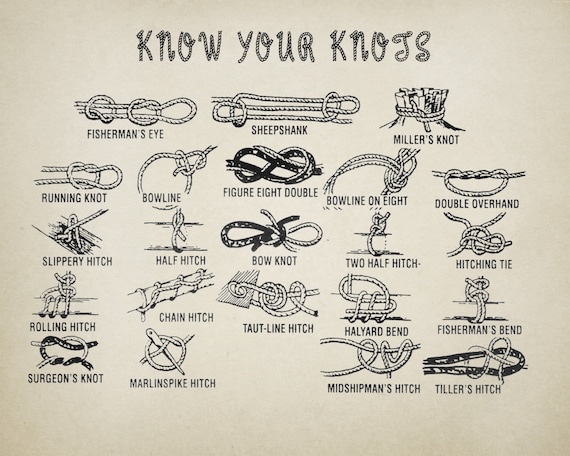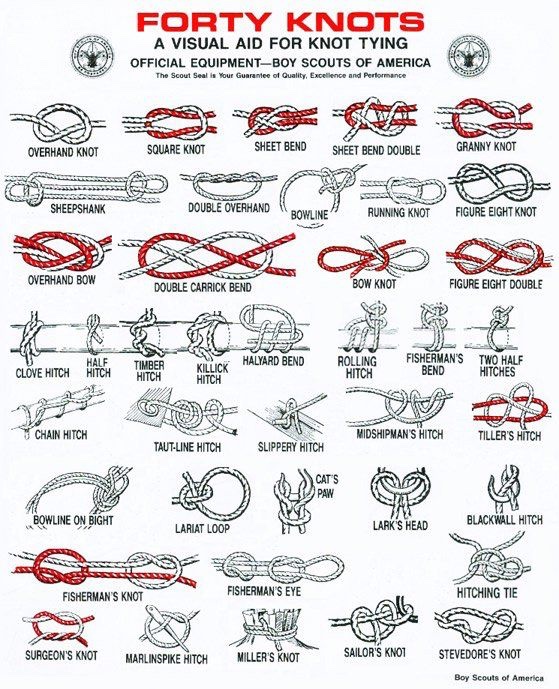
Why Is Learning to Tie Knots More Than Just a Skill?
Tying a knot might seem like a small thing — until you realize it’s something most of us were supposed to learn from our dad. I didn’t. And when I needed it, whether it was for camping, fixing gear, or just feeling confident, I had to figure it out myself.
It’s not just about rope. It’s about learning something useful and practical — and building that quiet kind of confidence we all want. If you’re figuring out life skills like this on your own, Simple Life Skills Every Man Should Know Without Feeling Dumb is a great place to keep going.
Which Knots Should Every Young Man Learn First?
Start with the basics. These aren’t just for scouts or sailors — they’re practical, useful, and teach discipline and focus.
- Square Knot (Reef Knot) – For tying two ropes of the same size together. Simple but effective.
- Bowline – Known as the “rescue knot.” It creates a fixed loop that won’t slip.
- Clove Hitch – Great for securing things temporarily, like tying up a tarp or a dog leash.
- Figure Eight Knot – Easy and safe stopper knot. Perfect for climbing, too.
- Taut-Line Hitch – A must-know for adjusting tension, especially for tents or tarps.
If your son’s learning hands-on life skills like this, they’ll benefit big time from Tying Knots Without a Father as a dedicated space to start.
How Can You Practice These Knots Without Fancy Gear?
You don’t need to go out and buy a $40 rope kit. Just grab an old shoelace, paracord, or even a length of clothesline. Keep it in your backpack or drawer. Practice during downtime — on the couch, outside, or in the garage.
This isn’t just about rope — it’s about focus, repetition, and patience. Skills like this also help young guys develop the discipline they need for everything from sports to learning how to start a fire or grill like a pro.

Why Is Learning These Skills Important for Fatherless Boys?
Because life can make you feel like you’re behind. Like everyone else was taught how to do things while you were left figuring it out alone.
Learning how to tie knots — and other hands-on, practical skills — gives you that feeling of, “I’ve got this.”
It’s a small win, but those stack up. The more wins you stack, the more confident you feel. It’s the same reason we teach our sons how to change the oil in a car, or why we remind ourselves to clean that dryer vent — because capable men aren’t born, they’re built.

What’s the Best Way to Teach a Son These Knots Without Overwhelming Him?
Make it a game. Make it part of something bigger. Don’t just say “go learn this.” Instead, say:
- “Hey, want to help me set up the tent?”
- “Let’s hang this tarp in the yard — I’ll show you the knot I learned.”
- “Can you help me tie this down in the truck bed?”
Let him see that the knot matters. Let him feel the purpose behind it. And most of all — celebrate the little wins. That’s where confidence is born.
Pair that moment with a quick lesson in how to spot bad tires, or how to tell when your car needs an oil change, and you’re giving him a well-rounded toolkit for life.
How Do You Keep These Skills Alive Over Time?
Consistency. Keep a rope in the glove box or a loop of paracord in his room. Make knot-tying a part of real-life situations — helping with yard work, securing stuff in the garage, or even setting up a hammock.
You could even write them on a piece of cardboard and hang them in the garage or man cave — next to The Man Cave Code if you’ve got it up on the wall.

What Other Lessons Should Go Along With Learning to Tie Knots?
Use this as a launching pad to teach:
- Patience – You won’t get every knot perfect the first time. That’s okay.
- Responsibility – Knowing something practical means being ready to help.
- Problem-solving – When something’s loose or broken, now you know what to do.
This small habit leads into bigger lessons — like learning to lead, work with your hands, and solve problems without waiting for someone else to show up.
And if you’re helping a son grow up without a dad around, you might also want to read How to Be a Gentleman: Teaching Your Son Respect, Dignity, and Strength as a companion piece.
Learning to tie knots can be a valuable and empowering skill for any child or man, regardless of their family circumstances. While some children may have fathers or father figures to guide them through this process, others may not have access to such guidance. If you find yourself in the latter situation, fear not! This article is here to help children learn how to tie knots on their own. Whether you’re a boy or a girl, this step-by-step guide will make knot-tying an exciting and accessible adventure.
1. Start with Simple Knots:
For beginners, it’s best to start with simple knots that are easy to master. One of the most straightforward knots is the “Overhand Knot”:
- Hold the end of the rope in one hand and create a loop with the other hand.
- Pass the end of the rope through the loop.
- Gently tighten the knot by pulling both ends of the rope.
2. Master the Square Knot:
The “Square Knot” is a useful and practical knot for everyday use:
- Cross the right end of the rope over the left end, forming an “X.”
- Pass the right end of the rope under the left end and pull it through the loop, creating a simple knot.
- Now, reverse the process: cross the left end of the rope over the right end to form another “X.”
- Pass the left end under the right end and pull it through the loop.
3. Embrace the Bow Knot (Shoelace Knot):
Learning to tie shoelaces is a rite of passage for any child. The “Bow Knot” is the familiar knot used for tying shoes:
- Cross one lace over the other to form an “X.”
- Loop one lace around the other, tucking it under the X to create a simple knot.
- Pull both ends to tighten the knot, forming a bow.
4. Conquer the Reef Knot:
The “Reef Knot” is excellent for securing items together:
- Cross the right end of the rope over the left end.
- Wrap the right end behind the left end and then over it, creating a loop.
- Pass the left end behind the right end and then over it, creating a second loop.
- Gently tighten the knot by pulling both ends of the rope.
5. Build Confidence with Practice:
As with any skill, practice makes perfect! Tie and untie these knots multiple times until you feel comfortable with the motions. Remember, it’s okay to make mistakes; that’s all part of the learning process!
6. Utilize Online Resources:
In this digital age, there are abundant online resources to aid your knot-tying journey. Watch tutorial videos or read step-by-step guides to reinforce your knowledge.
7. Seek Help from Mentors or Friends:
While you may not have a father figure to teach you directly, don’t hesitate to ask for help from other family members, friends, or mentors. Many people would be delighted to share their knot-tying expertise.
8. Embrace the Adventure:
Tying knots is like embarking on an exciting adventure. It’s a skill that will serve you well in various situations, from camping to everyday tasks.
Learning to tie knots is an empowering and essential skill for any child, irrespective of their family circumstances. With determination, practice, and the guidance provided in this step-by-step guide, you can become a knot-tying pro in no time. Remember that learning something new is a journey, and every step you take brings you closer to becoming a confident knot-tying master. So, grab your rope, and let the knot-tying adventure begin!

As an Amazon Associate we earn from qualifying purchases through some links in our articles.




